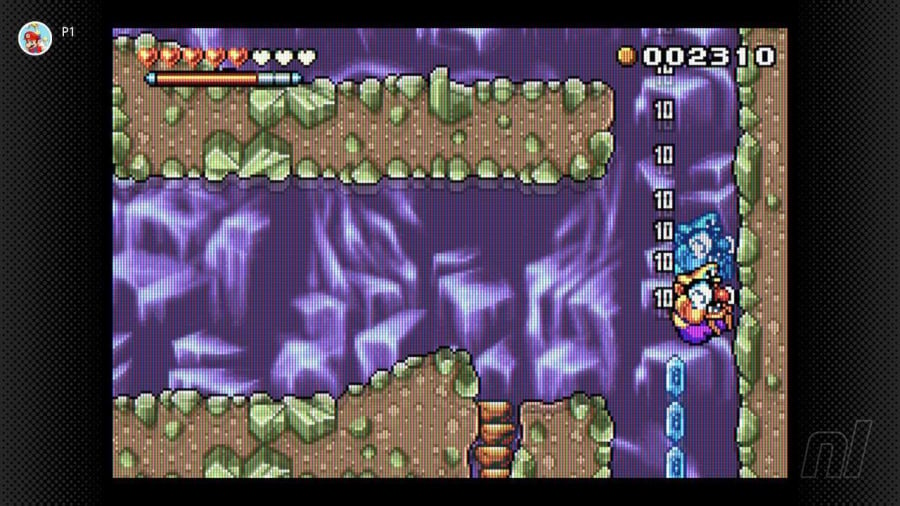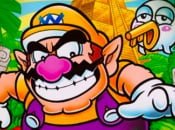
This review was originally published in May 2014. We’re updating and republishing it to mark the game’s arrival in the Nintendo Switch Online + Expansion Pack GBA library.
Although Wario’s core platforming series has been overshadowed for years by the surrealist microgames of WarioWare, his excellent platformers have the sort of devoted following that inspires 600-page eBooks. It’s easy to see why: Wario Land 4 takes the basic 2D platforming concepts of Mario and turns them on their head in an irreverent, boisterous adventure unafraid to take risks.
It’s hard not to compare Wario Land 4 to the first game in the WarioWare series, WarioWare, Inc.: Mega Microgame$!. Both were created by Nintendo R&D1 with largely the same development team; Wario Land 4 launched shortly after the Game Boy Advance hit stores in 2001, while WarioWare followed two years later. Aesthetically they’re two peas in a pod, with much of WarioWare’s trippy visual approach and outlandish musical style first pioneered in Wario Land.

It’s a bright, colourful game with lots of purple and gold to match its main character and goofy, ‘realistic’ pixel art that clashes humorously with the cartoonish primary art style. The soundtrack utilises the strange vocal samples WarioWare would become famous for, too, although some of the surreal music evokes another trippy Nintendo classic: EarthBound.
Perhaps in a nod to Birabuto Kingdom, the initial ancient Egyptian-style setting of its progenitor, Super Mario Land, Wario Land 4 tells the tale of our titular antihero plundering a mysterious gold pyramid for riches. Rather than a standard platformer, where all you have to do is reach the end of each level, Wario Land 4 has a handful of objectives: find the key that unlocks the next level; find the four jewel pieces that unlock the boss fight at the end of each world; activate a frog-shaped time bomb that destroys the entire level; race back to the beginning of the stage before the bomb goes off.

This structure has pros and cons. In many ways, it can feel very fetch-quest-y, with an arbitrary collection of magical MacGuffins required to advance to the next stage. But it also gives each one a sense of freedom and nonlinearity, like old Sonic zones, and a variation of pace between the beginning and end of a level.
The first half of each stage consists of exploring and searching for all the various collectibles, with the lack of a time limit encouraging you to take your time and savour your surroundings. The second half is after you’ve activated the time bomb, when the leisurely stroll becomes a frantic race to the beginning. R&D1 took its ‘meticulously explore the world and then escape total destruction at the end within a time limit’ concept from Metroid and applied it to every single level.
Wario sports your standard platforming controls, with D-pad movement, ‘A’ to jump, ‘B’ to attack, and ‘R’ to run, but there’s a whole host of extra abilities and mechanics you’ll need to master. When you knock an enemy upside down, you can pick them up and toss them; unlike throwing in Mario games (which is often a completely optional part of the plumber’s arsenal), Wario must master throwing at different speeds and angles to solve puzzles and defeat certain enemies.

That’s not all there is to learn: there’s also swimming, rolling, jump attacks, dash attacks, smash attacks, stomp jumps, and crouching jumps. You may well want to keep the manual handy for when you’re having trouble with some of the game’s obscure challenges. For example, one of Wario Land 4’s bosses is a cute rat riding an inflatable teddy bear. To damage it, you must:
- Avoid the parachuting nails being launched by the teddy bear, and jump on the nails in midair without destroying them
- Grab the nails and throw them up at the floating teddy bear so it deflates enough to lower into range of your jump attacks
- Wario has no direct straight-up attack, so his jump attack is simply smashing sideways and then jumping. Then you must jump up and hit the bear’s feet so the teddy rotates 180 degrees and reveals the rat on top
- Jump and hit the rat pilot while avoiding the fireballs it throws at you. Phew!
Only in that final step do you inflict damage, and if you mess up any other step, you have to start all over again. You repeat this process roughly a dozen times to defeat the boss. Oh, and you have to do it all within a four-minute time limit. While Mario is inviting to players of all ages and experience levels, Wario is aimed squarely at veterans.

One of the game’s selling points is Wario’s powers. Like Kirby, he gains abilities from certain enemies and uses them to conquer foes and solve puzzles. But it’s a sick, Garbage Pail Kids twist on the Kirby mechanic: instead of defeating enemies to gain their powers, Wario gets powers when he’s attacked – and they’re all sadistic punishments for the portly protagonist.
If he’s hit by an apple, he swallows it and becomes ‘Fat Wario’, a grotesque colossus straight out of Monty Python who lumbers slowly but can smash through walls. If he’s stung by a bee, he has a catastrophic allergic reaction and balloons into ‘Puffy Wario’, who involuntarily floats to the ceiling. He also gets flattened, set on fire, zombified, and buried in snow, all in the name of ‘abilities’.
True to his Game Boy roots, Wario’s sprite takes up a huge percentage of the screen, but that’s actually a good thing: his silly, incredibly detailed animations are one of the highlights of the game, and it’s fun just to watch him walk around. In today’s 3D world of polygonal protagonists, Wario Land shows us the lost artistry of immaculate sprite design, as every action he performs oozes his arrogant, larger-than-life personality.

Sometimes Wario’s giant sprite can get in the way — mounting the top of ladders to climb down can be a hassle since he’s so wide and you have to stand exactly in the middle of the ladder tile — but for the most part, it simply adds humour, as you make this massive man crouch through tunnels and shimmy across ice patches. Unfortunately, the enemy designs didn’t get as much love as Wario himself; most of the bad guys you’ll face are forgettable platforming fare.
The uninspired enemies pale in comparison to its genius level design, though; Wario Land 4 features wildly unorthodox, imaginative, and varied stages. Unlike many platformers whose art styles are essentially window dressing, Wario Land 4 incorporates each level’s theme into its design. One stage has you finding your way through a huge hotel, while another is a giant trash heap with almost entirely destructible environments. There’s a level inside a toy box where you move children’s building blocks to advance, and perhaps as a nod to Sonic, there’s a pinball-themed stage as well.

Aside from the main platforming levels, Wario Land 4 foreshadows WarioWare with a handful of minigames: there’s an Atari 2600-style baseball game, a single-button obstacle jumping game, and a ‘remember the face’ barbershop game. They’re all fairly unremarkable and serve as a sort of currency exchange; the points you earn in the main game can be traded for rounds at the minigames, and succeeding in those earns you coins you can spend on items to help you in boss battles. Why couldn’t we just purchase items with our points from the main game? The minigames can feel like middleman busywork, but they’re a nice change of pace and were a hint of things to come.
Conclusion
Wario Land 4 is a fairly short experience, with a main campaign that can be finished in under 10 hours on normal difficulty. It’s quality over quantity though, as the clever, nonlinear level structures lend themselves to multiple playthroughs and further exploration to unlock all the extras. It’s a platformer for platforming veterans, with mechanics that could be deep and rewarding to some but overwhelmingly daunting to others. Ultimately, Wario Land 4 is full of impeccable level design and a quirky audiovisual presentation that set the precedent for WarioWare. If you’re not a big fan of platformers, Wario Land 4 will only frustrate you, but for everyone else, it’s a must-play.











